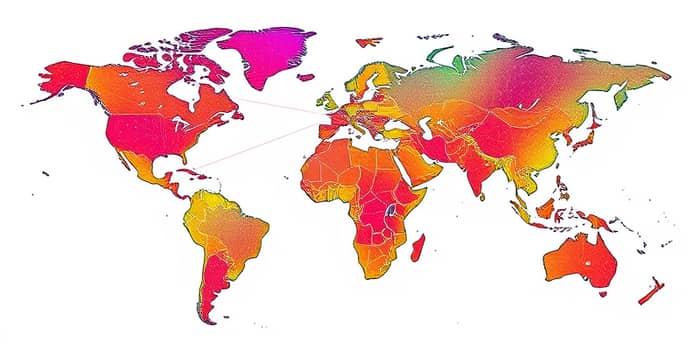In 2025, the way money moves across the world has undergone a profound shift, redefining commerce and connectivity.
Introduction: Payments in 2025—A Global, Digital, and Instant Reality
The payments landscape has reached a pivotal moment of transformation, driven by advances in technology, regulation, and consumer demand. From bustling city streets where contactless tap-and-go is the norm, to underserved regions leapfrogging traditional banking with mobile wallets, the era of slow, cumbersome transactions is fading.
As global revenues surpass $2.4 trillion and are set to hit $3.1 trillion by 2028, payment providers, banks, and fintech startups alike must embrace an ethos of instant, global, and seamless solutions. Businesses that harness these trends will unlock new revenue streams and deepen customer trust, positioning themselves at the forefront of financial innovation.
The Numbers: Market Size, Volumes, Regional Growth
By 2028, payments will represent nearly 35% of total banking revenue, underscoring their growing strategic importance. Annual growth rates vary by region, reflecting differences in infrastructure, consumer behavior, and regulation. Understanding these patterns is essential for businesses and policymakers alike.
This regional snapshot reveals where opportunities lie, from Europe’s regulatory-driven expansion of contactless payments to Latin America’s leap in financial inclusion through mobile wallets and real-time systems like PIX. Merchant acquiring revenue is expected to exceed $160 billion by 2026, underscoring the commercial opportunities for payment processors.
The Engines: Digital Wallets, Instant Payments, RTP Rails
Digital wallets have surged, set to process $25 trillion by 2027. These platforms satisfy a universal desire for convenience, speed, and security, effectively replacing paper cash and plastic cards. Meanwhile, real-time payment (RTP) networks are rewriting the playbook for fund transfers.
- India’s UPI: Over 18.6 billion transactions in May 2025, handling ₹25.1 trillion in value.
- Brazil’s PIX: 41 billion transactions in 2023, used by more than 70% of adults.
- Europe: SEPA Instant Credit Transfer and TIPS facilitating multi-currency instant transfers.
- Emerging Economies: Mobile rails driving inclusion across Africa and Latin America.
AI-driven intelligence is optimizing these systems, reducing latency and enhancing user experiences. As stakeholders refine their offerings, the emphasis on a mobile-first commerce revolution will only intensify, shaping the next generation of payment interfaces.
Going Global: Seamless, Cross-Border & Multi-Currency Payments
The cross-border payments market, valued at roughly $200 trillion, is expected to surge to $320 trillion in the coming years. Yet traditional corridors can be costly and slow. Regulatory frameworks in the EU and initiatives by the ECB to interlink systems like TIPS are setting new standards for speed and affordability.
Key efforts include mandatory instant payment mandates across all EU banks and interoperable infrastructures in regions such as the Western Balkans. Integration of anti-money laundering protocols and KYC checks into these fast rails ensures compliance without sacrificing speed. Banks and fintechs that leverage these networks will unlock new corridors of trade, remittance, and commerce, enabling seamlessly integrated into everyday life transactions across borders.
The Experience: Unified Commerce & Embedded Payments
Today’s consumers expect to shop and pay anywhere—online, in-app, on social channels, or at the point of sale. Unified commerce solutions break down silos between channels, ensuring inventory, pricing, and promotions flow seamlessly. This holistic view fosters customer loyalty and simplifies operations.
Embedded payments are also expanding beyond B2C to B2B, streamlining invoicing, reconciliation, and settlements within enterprise workflows. For merchants, adopting payment orchestration platforms provides the agility to route transactions through optimal providers, maximizing approval rates and minimizing costs in real time.
By designing experiences that feel frictionless, brands can differentiate themselves and cultivate lasting relationships. Practical steps include integrating digital wallets at checkout, offering buy-now-pay-later options, and unifying data across CRM and payment gateways.
Security First: AI, Digital Identity, and Fraud Prevention
As the volume and velocity of transactions accelerate, so do the risks. Payment fraud is projected to grow by $10 billion between 2023 and 2028. Leveraging AI for anomaly detection and risk scoring is no longer optional—it is a cornerstone of payment security.
Advanced authentication methods, such as biometric verification and tokenization, reinforce digital identities while enhancing the user experience. Collaboration among banks, regulators, and fintechs is essential for developing robust frameworks that deter bad actors, ensuring that instant does not mean insecure.
Regulation and the Rise of CBDCs: Trust, Inclusion, and Oversight
Central Bank Digital Currencies (CBDCs) are emerging as tools for promoting financial inclusion and modernizing monetary policy. By offering a digital equivalent to cash with programmable features, CBDCs can reduce settlement times and lower transaction costs. Pilot programs in the Bahamas and China have demonstrated faster cross-border settlement capabilities and improved transparency.
Innovations in interoperability and privacy-enhancing technologies will determine the success of these initiatives. Building trust in CBDCs will require clear communication of privacy protections and ensuring end users understand how digital tokens function within existing financial ecosystems. Coordination with the private sector is crucial to establish standards and governance frameworks that balance innovation with compliance.
The Road Ahead: Innovation, Risks, and Future Prospects
The payments landscape will continue to evolve, driven by consumer expectations, technological breakthroughs, and regulatory shifts. Key innovation hotspots include decentralized finance, tokenization of real-world assets, and embedded finance in non-traditional platforms.
Yet challenges persist: cybersecurity threats loom large, and geopolitical uncertainties could affect investment flows. Organizations that proactively embrace collaboration, standardization, and continuous improvement will be best positioned to thrive. By prioritizing security, usability, and inclusivity, the industry can deliver on the promise of truly instant payment rails at scale, shaping a future where commerce knows no bounds.
References
- https://gr4vy.com/posts/112-payment-industry-statistics-for-2025-trends-costs-methods-and-more/
- https://planergy.com/blog/global-payments-trends-2025/
- https://www.statista.com/topics/11646/digital-payment-trends/
- https://www.centralbanking.com/benchmarking/payments/7973040/instant-payment-system-adoption-grows-165-year-on-year
- https://www.globalpayments.com/commerce-payment-trends
- https://www.ecb.europa.eu/press/key/date/2025/html/ecb.sp250627~de084f5b69.en.html
- https://www.emerchantpay.com/insights/global-payments-outlook-2025-unlocking-the-potential-of-digital-payments/
- https://paymentscmi.com/insights/top-global-payment-methods/










